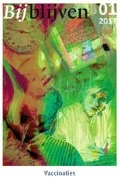Samenvatting
Symptoomcontrole bij kanker is een uitdaging voor de gezondheidszorg van de eenentwintigste eeuw. In het Cancer Pain programme van de who is de drietraps pijnladder een centraal element: naarmate de pijn intenser wordt, wordt zij behandeld met steeds krachtiger farmaca (voornamelijk opioïden). Deze benadering laat andere behandelingen echter buiten beschouwing, zoals antikankerbehandelingen, chirurgische interventies, nieuwe farmacologische benaderingen en psychologische en aanvullende therapieën. Wij stellen een nieuw, multidimensionaal model voor, gebaseerd op een piramide, dat de symptoomcontrole bij kanker benadert vanuit verschillende invalshoeken en daardoor een werkelijk multimodale en multidisciplinaire behandeling waarborgt. Het model vormt ook de basis voor een meer holistische benadering van de patiënt, waarin onderzoek, behandeling en evaluatie een geïntegreerd geheel vormen. Ons piramidemodel heeft ‘metapiramiden’, nieuwe piramiden afgeleid van elk vlak van de piramide, die een steeds dieper niveau van detaillering mogelijk maken. Het laat zich daardoor gemakkelijk aanpassen aan andere symptomen dan pijn alleen. Wij presenteren vier manieren om dit nieuwe piramidemodel te valideren in termen van aanvaardbaarheid, wetenschappelijke betrouwbaarheid en klinische bruikbaarheid.



Literatuur
Sikora K. Developing a global strategy for cancer. Eur J Cancer 1999;35:24-31.
Bonica J. Cancer pain. In: Bonica J, editor. The management of pain. 2nd ed. Philadelphia: Lea and Febiger, 1990:400-600.
Daut R, Cleeland C. The prevalence and severity of pain in cancer. Cancer 1982;50:1913-18.
Donelly S, Walsh D. The symptoms of advanced cancer. Semin Oncolog 1995; 22: 67-72.
Doyle D, Geoffry W, Hanks C, MacDonald N. Oxford textbook of palliative medicine, 2nd ed. Oxford: Oxford University Press, 1998.
World Health Organization. Cancer pain relief. Geneva:who, 1986.
World Health Organization. Cancer pain relief with a guide to opioid availabiltiy. Geneva:who, 1996.
Jacox A, Carr DB, Payne R, et al. Management of cancer pain. Clinical Guideline No. 9. Rockville (MD): Agency for Health Care Policy and Research, 1994.ahcpr Publication No. 94-0592.
Schug S, Zech D, Dörr U. Cancer pain management according towho analgesic guidelines. J Pain Symptom Manage 1990;5:27-32.
Ventafridda G, Caraceni A, Sbanotto A, Barletta L, De Conno F. Pain treatment in cancer of the pancreas. Eur J Surg Oncol 1990;16:1-6.
Expert Working Group of the European Association for Palliative Care. Morphine in cancer pain: modes of administration. BMJ 1996;312:823-6.
Goisis A, Gorini M, Ratti, Luliri P. Application of awho protocol on medical therapy for oncologic pain in an internal medicine hospital. Tumori 1989;75:470-2.
Zech D, Grond S, Lynch J, et al. Validation of the World Health Organization Guidelines for cancer pain relief, a 10 year prospective study. Pain 1995;63:65-76.
Ahmedzai S. New approaches to pain control in patients with cancer. Eur J Cancer 1997;33(suppl 6):8-14.
Alejandro R, Jadad MD, Phil D, et al. Thewho analgesic ladder for cancer pain management – stepping up the quality of its evaluation. JAMA 1995;274:23.
Twycross R. Pain relief in advanced cancer. Edinburgh: Churchill Livingstone, 1994.
Portenoy R, Lesage P. Management of cancer pain. Lancet 1999;353:1695-700.
De Conno F, Caraceni A. Manual of cancer pain. Dordrecht: Kluwer Academic Publishers, 1996.
Bernabei R, Gambassi G, Lapane K, et al. Management of pain in elderly patients with cancer. SAGE Study Group. Systematic Assessment of Geriatric Drug Use via Epidemiology. JAMA 1998;279:1877-82.
Faull C, Woof R. Palliative care, an Oxford core text. Oxford: Oxford University Press, 2002.
Author information
Authors and Affiliations
Additional information
Prof. dr. Bart Van den Eynden, huisarts-palliatief arts, Academisch Centrum voor Huisartsgeneeskunde, palliatieve eenheid Gasthuis Sint-Camillus, Universiteit Antwerpen, Antwerpen, België.
Andreas Lübbe, Cecilien-Klinik, Bad Lippspringe, Duitsland.
Sam Ahmedzai, Palliative Medicine Department, University of Sheffield, Floor Halamshire Hospital, UK
Rights and permissions
About this article
Cite this article
Van den Eynden, B., Lübbe, A. & Ahmedzai, S. Een nieuw paradigma voor symptoomcontrole bij kankerpatiënten – het piramidemodel. BIJB 22, 47–52 (2006). https://doi.org/10.1007/BF03059910
Issue Date:
DOI: https://doi.org/10.1007/BF03059910

